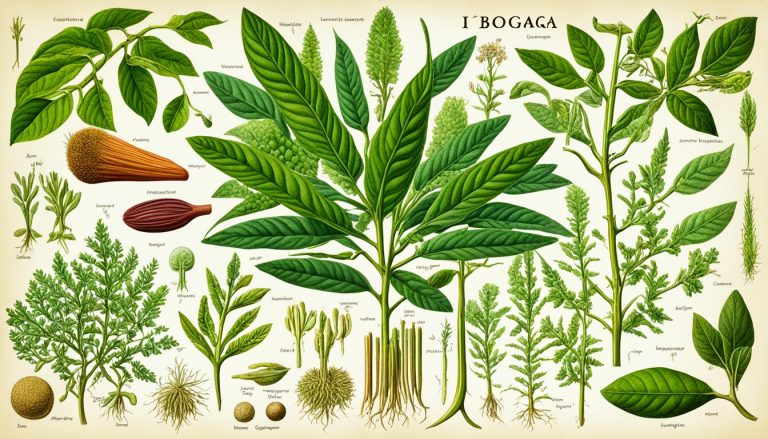What Is Ibogaine?

In the realm of psychoactive substances, few are as enigmatic and steeped in tradition as ibogaine. Often posed as a question—what is ibogaine?—this naturally sourced compound ignites curiosity and fascination in equal measure. Originating from the roots of the Central African shrub known as Tabernanthe iboga, ibogaine is recognized for its powerful psychoactive properties that span the realms of psychedelic and dissociative experiences.
At the core of ibogaine therapy lies a multifaceted potential that has attracted individuals from around the world. Whether it’s an ibogaine experience that promises spiritual awakening or a serious attempt at conquering the chains of addiction, the substance beckons with the promise of transformation. However, while some recount profound journeys of healing and self-discovery, others caution against the risks associated with its use. As we delve into the story of ibogaine, we weigh its controversial acclaim against the backdrop of modern science and traditional wisdom.
Key Takeaways
- Ibogaine is a psychoactive compound with dissociative effects, used traditionally for spiritual exploration and addiction treatment.
- Ibogaine therapy is sought after for its perceived ability to facilitate deep psychological introspection and potential aid in substance addiction recovery.
- The unique ibogaine experience, characterized by oneirogenic or dreamlike introspective states, is at the forefront of its notability.
- Preliminary research on ibogaine has indicated possible benefits, yet its use is inherently tied to significant legal and health safety concerns.
- Understanding the full scope of ibogaine requires navigating the complexity of its effects, the controversies surrounding its use, and its diverse legal status worldwide.
Understanding Ibogaine and Its Origins
The substance known as ibogaine is more than just a topic of modern scientific inquiry; it is deeply entrenched in centuries of tradition and cultural practices. Despite its contemporary exploration, particularly with ibogaine for addiction, the substance’s roots reach back through the annals of African spiritual traditions to the very essence of shamanic healing rituals.
The Historical Context of Ibogaine
Ibogaine’s journey into the contemporary limelight began with the Pygmy tribes of Central Africa, who first harnessed its psychoactive effects. The baton of knowledge was passed to the Bwiti tribe in Gabon, who revered the iboga plant’s transformative properties. By the late 19th century, French explorers had transported ibogaine to European shores, initially marketing it as a mere stimulant. Yet, it is this historical voyage that has paved the way for the ibogaine detox treatments sought after today.
Traditional Use in Shamanic Rituals
Shamanic traditions, as practiced by the Bwiti, involve the consumption of significant quantities of iboga root bark, leading to intense, multifaceted psychoactive experiences. These rituals, which have stood the test of time, underscore the profound spiritual and healing dimensions associated with ibogaine. Today’s ibogaine clinics strive to understand and contextualize this traditional use within the framework of modern medical practices and addiction therapy.
Despite its legacy and potential as a tool for battling addiction, ibogaine finds itself caught in a complex web of international legal scrutiny. It persists as an unscheduled substance under the United Nations, yet faces varied legal standings from one country to the next, influencing where and how ibogaine detox programs can operate. In some regions, ibogaine remains a prescription entity, indicating a cautious but recognized therapeutic value.
The rich historical tapestry and varied current-day applications of ibogaine continue to intrigue and inspire those seeking alternatives in the realm of addiction treatment, and its story is still very much in the making.
How Ibogaine Interacts with the Brain
Ibogaine research delves deep into the substance’s intriguing interaction with the brain, particularly spotlighting its role as a serotonin reuptake inhibitor. This key activity contributes to the myriad of effects experienced during an ibogaine session. Additionally, the compound’s moderate influence on κ-opioid receptors, coupled with its weak agonism at μ-opioid receptors, manifests in its ability to prompt a profound altered state of consciousness. Users describe entering a dreamlike introspection period, during which they confront inner emotional challenges and traumas—a therapeutic phenomenon potentially beneficial for substance dependency treatments.

Exploring the ibogaine side effects is an essential component of ongoing studies, as they underscore the substance’s complex nature. The dissociative experience ibogaine induces is often described as oneirogenic, allowing individuals to process psychological hurdles in what feels like a waking dream. Extended benefits are attributed to its metabolite, noribogaine, which is thought to be more potent as a serotonin reuptake inhibitor and extends the substance’s effects well after initial consumption.
Understanding how ibogaine and its metabolite noribogaine prolong their impact on the serotonin system is crucial for illuminating the pathway to potential treatments for various disorders, especially addiction.
Investigations continue into how these interactions can be harnessed safely, providing valuable insights into innovative methods for combatting substance abuse and various emotional disorders.
Investigating the Therapeutic Potential of Ibogaine
When delving into the realm of alternative treatments for mental health and substance disorders, ibogaine therapy stands out with compelling historical roots and modern-day implications. With ongoing discussions surrounding its efficacy and safety, the exploration into ibogaine’s role in therapy continues to unravel its complexities and potential as a transformative agent in medicine.
Ibogaine as an Antidepressant
The psychoactive substance ibogaine, initially utilized under the moniker Lambarène, has shown promising potential as an antidepressant in historical medical practices. Recognizing the ibogaine benefits within this scope, the substance acted simultaneously as a stimulant, offering a multifaceted approach to managing mood disorders. Yet, despite these early inklings of therapeutic prowess, ibogaine’s clinical use has been significantly hampered by its legal standing and concerns about cardiotoxic effects.
Implications for Addiction Treatment
Research into ibogaine’s capabilities extends into addiction treatment, where animal studies have alluded to its potential in curbing dependencies on substances like heroin, morphine, cocaine, and alcohol. This glimpse into the value of ibogaine therapy propelled the FDA to green-light initial clinical trials for treating cocaine addiction—trials that, despite their promise, remained incomplete. Faced with the dual-faced nature of ibogaine—therapeutic yet hazardous—the scientific community is actively searching for less harmful analogs that retain ibogaine’s benefits, envisioning a future where addiction treatment is revolutionized sans risk.
Ibogaine’s Legal Landscape around the World
The intricate tapestry of global regulations paints a diverse ibogaine legal status map. In the United States, this substance is a Schedule I drug, which is to say, it’s both illegal and recognized as having a high potential for abuse with no accepted medical use. This classification has heavily influenced the perception and availability of ibogaine treatment within the country’s borders.
By contrast, some nations adopt a more permissive stance towards ibogaine, aligning with their focus on progressive drug policies and harm reduction paradigms. Countries like Australia, Canada, and New Zealand categorize ibogaine as a prescription medication, thus recognizing its potential therapeutic value under supervised conditions. This regulatory flexibility allows for more structured research and a clinical approach to ibogaine’s application in addiction treatment.
Unburdened by the conventions of international scheduling, ibogaine remains entirely unscheduled by the United Nations. This lack of uniform classification underscores the complexities and controversies surrounding its legal status and use. In countries where ibogaine is either legal or can be prescribed, specialized rehabilitation facilities offer treatments, often operating on the fringe of mainstream healthcare systems.
Despite its varying legal acceptance, the primary challenge hindering ibogaine’s global therapeutic embrace lies not in its potential, but in the dearth of comprehensive, methodically sound research informed by its complex legal scene.
The future of ibogaine hangs in a delicate balance between its therapeutic promise and the omnipresent shadows of legal restrictions and societal skepticism. However, those jurisdictions that do allow its use may indeed be the proving grounds for its efficacy and safety as a unique treatment modality.
The Risks and Considerations of Ibogaine Usage
Exploring the potential of ibogaine as a transformative treatment comes with the responsibility of understanding its ibogaine side effects. While the ibogaine experience is often described as life-changing, it’s crucial to recognize the significant risks attached. The psychoactive nature of ibogaine can lead to profound shifts in perceptions and consciousness, which, in some cases, have proven to be fatal.
Understanding the Side Effects
Those considering ibogaine treatments must brace themselves for possible side effects, which range from mild discomfort to severe physiological disturbances. Experiencing ataxia, nausea, and episodes of vomiting are commonly reported. However, it’s the severe cardiovascular effects, such as the development of long QT syndrome, that raise considerable alarm. The complexities of ibogaine are not to be underestimated, as its side effects can leave lasting marks on one’s health.
Mitigating Potential Risks
To mitigate these potential risks, meticulous preparation and comprehensive monitoring are vital. Ibogaine’s ability to interact with other pharmaceuticals—especially psychiatric medications—can further exacerbate adverse reactions. This underscores the importance of a thorough medical evaluation and avoidance of harmful drug interactions. While the quest for healing and transformation can lead one to seek out ibogaine, safety should be the lighthouse guiding that journey, particularly when venturing into the waters of unregulated treatment facilities.
For those considering or delivering ibogaine treatments, the onus is on both parties to ensure all safety protocols are in place, transforming the ibogaine experience from one of uncertainty to a tale of recovery and enlightenment.
Personal Anecdotes and Experiences with Ibogaine
Delving into the heart of the ibogaine experience, personal stories often shed light on the profound impact it can have on an individual’s psyche. Many recount their ibogaine treatment as a pivotal moment of transformation, facilitating a deep introspection and re-evaluation of past traumas. Such experiences are deeply personal and unique, resonating with the complexities of human emotions and the intricacies of psychological healing.
However, these encounters with ibogaine’s potent effects are as varied as the individuals themselves. While some narratives speak of a newfound clarity and a breakthrough in addiction recovery, others may find their journeys with ibogaine less definitive. It’s important for observers to understand that each ibogaine experience is subjective, and while some may portray it as a miraculous substance, for others, the outcomes are less predictable.
The dynamic and enigmatic nature of ibogaine continues to intrigue and provoke thought, making it a source of both hope and caution within therapeutic circles. Such dualities reflect the essence of ibogaine – a substance that carries both the potential for deep healing and significant risks.
As we navigate through these personal anecdotes, we encounter a tapestry of human resilience and the quest for well-being. The journeys, marked by their intensity and the sheer will to overcome, are testaments to the search for alternative paths in addressing some of life’s most challenging obstacles. The ibogaine treatment stories, whether they end in triumph or in continued struggle, are crucial narratives that inform our collective understanding of this controversial and enigmatic substance.
The Future of Ibogaine Research and Development
The quest to harness ibogaine benefits without its associated risks is leading to groundbreaking advancements in pharmacological research. At the forefront is the synthesis of innovative drug derivatives designed to echo the compelling outcomes of traditional ibogaine therapy. These efforts not only reflect scientific ingenuity but also a commitment to expanding the horizons of addiction treatment and mental health care.
Innovative Drug Derivatives Based on Ibogaine
In the laboratory, a new class of compounds inspired by ibogaine’s chemical structure is emerging. Pioneering scientists are developing these derivatives to emulate the original molecule’s therapeutic action—primarily its interaction with the serotonin transporter, which is central to ibogaine’s potential as a treatment for various addictive behaviors. Computational docking and rational drug design are aiding in the creation of these novel molecules which promise to minimize adverse side effects while maximizing efficacy.
Progress Toward Clinical Acceptance
As ibogaine research progresses, the journey from experimental to medically accepted use is taking shape. The discovery of selective serotonin transporter inhibitors derived from ibogaine’s chemical backbone offers a clearer path toward clinical use. This potential shift towards evidence-based application could evolve ibogaine from an ethnobotanical enigma into a cornerstone of psychiatric medicine. By leveraging modern computational methods and collaborative research initiatives, there’s hope that ibogaine’s therapeutic potential will soon be realized within the framework of clinical science.
Conclusion
At the intersection of indigenous tradition, innovative therapy, and meticulous research stands ibogaine — a substance encountered upon asking what is ibogaine. As the narrative of this compound unfolds, it portrays a paradox between potential breakthroughs in ibogaine therapy and a stringent regulatory atmosphere. Understanding ibogaine is key to unraveling its dual nature: a beacon of hope for those grappling with addiction juxtaposed against the backdrop of possible adverse effects.
Advances in ibogaine research are paving new pathways towards developing safer derivatives, offering a glimpse of the transformative impact ibogaine may have on treating addiction and mental health disorders in the future. The substance’s complex pharmacology beckons further exploration to firmly establish its therapeutic efficacy and safety profile. Testimonials from those who’ve undergone ibogaine therapy speak volumes, yet the scientific community’s endorsement is vital for it to transcend from anecdotal to clinically verified treatment.
The evolution of ibogaine’s story is a testament to our perpetual quest for healing and understanding. As researchers labor to mitigate its risks and lawmakers contemplate its legal status, ibogaine’s journey from an obscure alkaloid to a legitimate medical treatment continues. Posed to potentially revolutionize addiction and mental health care, ibogaine’s prospective future hinges on a balanced embrace of its rich potential and a prudent approach to its inherent challenges.






